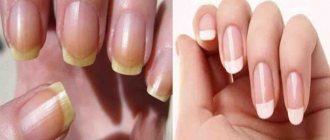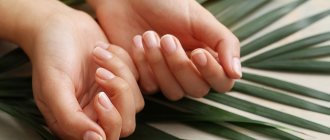Every woman strives to be well-groomed and look good in everyday life, not to mention festive events and parties. Beauty lies in the details, so it’s not surprising that such importance and attention is paid to nails. It is not always enough to just put makeup on them; they must be correct, the same shape, healthy, and the skin around them must be moisturized and smooth. Many cosmetic procedures not only have aesthetic value, but also have health benefits. This can be said about polishing the nail plates, which can be done both in the salon and independently at home.
Why and how to polish
First of all, you need to know that polishing nails is carried out not only for their beautiful appearance, but also for health, since in the process of creating a glossy appearance, blood begins to circulate better, which in turn leads to their growth.
That is why, in order for your nails to have a beautiful and healthy appearance, they must be polished. However, quite often you should not resort to rubbing your nails until they shine as they can become fragile. It is enough to carry out this process no more than 1-2 times a month. The grinding process consists of several stages:
- Surface grinding (soft). It helps remove the moisture that they produce from the nails and speed up the process of renewing their layer. Also, using soft sanding, you can remove the unsightly yellow color of your nails and make them more even.
- Primary polishing. It removes small scratches and evens out the keratin layer.
- Secondary polishing. This procedure makes your nails more glossy and gives them a beautiful color.
How to use a nail file correctly
You need to know how to use a file correctly. During the procedure, the instrument is held on both sides: with the help of the thumb it is held on one side, and with the index and middle fingers on the other. It is necessary to process the nails, moving in one direction from the edge to the middle; during the procedure, the file must be held at a small angle relative to the plate.
And a few more rules:
- You should choose a polishing file with a soft foam base;
- When polishing, you must hold the file with your fingers on both sides, pressing lightly and evenly over the entire surface. Then it will cover the entire nail;
- In order for the effect of polishing to be maximum, that is, so that after the procedure the nails not only look, but also remain healthy, you can first apply a little nourishing cream or suitable essential oil for nails to the nail plate;
- Thanks to polishing, the subsequently applied varnish will lie smoother and last longer.
Material
You may be interested in: Pink manicure with silver: interesting fashion ideas, examples of color combinations
When correctly compiling the necessary list of attachments for a manicure machine that a beginner needs, you should first familiarize yourself with their description and purpose. According to the material of the device there are:
- Ceramic. They are safe because they are very soft. The products do not heat up, do not become clogged with dust, and do not rust. The main disadvantage is considered to be instability to wear. They are usually used to work with a recently purchased device in order to get used to it. The abrasiveness index can be in the range of 100-400 microns. Fine-grained cutters perform polishing of nails and final work on the skin. Medium-grained ones are used in cuticle processing. And with the help of coarse-grained ones, dead skin is removed.
- Diamond. They are more rigid, functional, and are used for polishing natural and extended nails, modeling the free edge of the nail, processing and polishing the side ridges, the space between the fingers, and calluses. There are natural diamonds and artificial diamond chips on sale.
- Carbide. They are also called corundum. They are used at the beginning of a hardware manicure to remove rough skin, hard calluses, remove acrylic, treat hard-to-reach areas and work with ingrown nails. The devices are suitable for working with artificial nails. The nozzles heat up slightly, so they do not cause discomfort. It is advisable to choose them with a speed of up to 15,000.
- Steel. The teeth are obtained by cutting or stamping. Often the device is oxidized to improve performance properties.
Polishing at home
It is not necessary to visit a salon to give your nails a healthy and beautiful look. Polishing can be done at home; for this you only need to have a special file (with an abrasiveness of 300 grit or more). It is also better to purchase a special polish and cream that are applied to the nails after the procedure. This is very important, since after the rubbing process they need restoration and vitamins necessary for their health and beauty.
DIY process:
- Prepare the bath. To do this, take a small amount of not hot water and add a few tablespoons of lemon juice or regular salt to it;
- Place your hands in the solution and let it steam;
- Prepare your nails. Remove any remnants of the previous manicure and cut to the desired length;
- Using an orange stick, carefully remove the cuticle;
- Using the buff, start polishing. Direct it in one direction from the very end of the nail to its center.
- Do the same with all fingers;
- I use a fine spray on a nail file to polish my nails until they become shiny.
- Apply nourishing or restorative cream.
Don’t be upset if you don’t have a special nail file at hand for polishing your nails. Many girls don’t know how to polish their nails without a file, but it’s quite easy and simple. You need to take a suitable piece of fabric, but it must be suede, and apply a little starch on it and the nail file replacement is ready.
The best ceramic nail files
Double-sided ceramic file TITANIA (1034.B)
: 4.9
The gold was given to a professional brand instrument from Germany. European quality guarantees long-term use. The file provides gentle care for unhealthy, brittle nails. With its help, you can prevent delamination and make your hands well-groomed and beautiful without going to the salon. The product has two coatings of different degrees of abrasiveness. One is intended for adjusting the length and creating a shape, the other, softer, is for grinding.
The TITANIA product comes with an additional nail cleaner. The durable plastic case prevents dirt and dust from getting inside, ensuring hygienic cleanliness during storage and travel. The caps are firmly fixed to the base. To work with one side there is no need to unscrew and remove the case on the other. The ceramic surface is easy to clean from saw cuts.
Reviews confirm the functionality and practicality of the product. It is not only comfortable to use, but also looks aesthetically attractive. Affordable price is another undoubted advantage of this nail file.
Advantages
- German production;
- careful action;
- road version;
- additional nozzle.
Flaws
Ceramic file Dr. Alex, 180/180
: 4.8
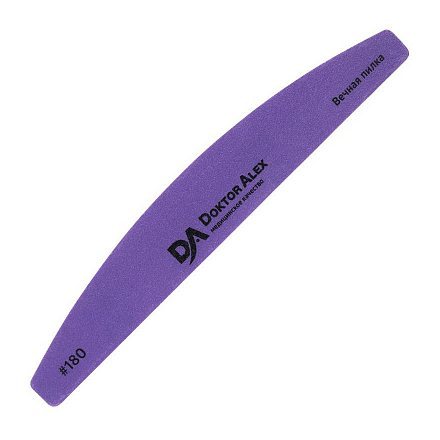
The second is a product developed by a popular brand in the salon business. It offers innovative tools and materials for commercial and domestic use, which are in great demand in the Russian market. A professional file designed for natural nails. It does not damage the plate, restores the brittle, layered structure, and seals the edges.
Delicate action leads to quick and high-quality results. The product has an abrasiveness of 180 gr. The special shape allows you to perform actions in any direction, adjusting the length and giving shape. The abrasive surface is wear-resistant. It does not lose its original properties during intensive use. The file is moisture-resistant, so it can not only be cleaned dry, but also washed in water, and also disinfected.
The opinions of experts and customers coincide. The file meets all efficiency and safety requirements. It is convenient to use and care for. With the tool you can process any hard-to-reach areas without loss of quality.
Advantages
- durable, gentle coating;
- restoration of nail health;
- dry and wet cleansing;
- comfortable uniform for work.
Flaws
Ceramic file Silva
: 4.7

In third place is a ceramic file, which will carefully remove the cuticle and hard side ridges and help create any plate shape. The natural material used in production is intended for both healthy nails and brittle and weak ones. It does not damage them or injure the skin. The manicure tool is easy to use. They can be used to file the nail in different directions, while protecting the edge from splitting.
The product can be used anywhere as needed. It is convenient to take it on long trips, as it comes with a durable storage case. With it, your hands will always be well-groomed without visiting the salon. To clean, simply remove the remaining sawdust with a brush or a soft, dry sponge. Ceramic abrasive lasts a very long time. It retains its characteristics for a long time.
The Silva brand follows all modern trends, offering customers reliable, wear-resistant and effective products. The file was highly appreciated by both masters and ordinary girls and gave it “good” and “excellent” ratings.
Advantages
- universal application;
- delicate filing;
- durable plastic case;
- convenient bar shape.
Flaws
Types of polishing files
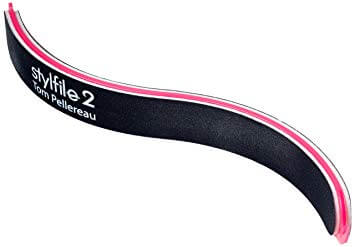
There are many types of polishing files: special polishing files, polishing blocks, buffs. There are professional files that are made of durable materials with a long service life. They can be washed and disinfected. They are certainly suitable for home use too. If you care about the health of your nails, it is better to choose a professional tool. It will cost more, but it will last longer and will not harm your nails.
Polishing files
Special polishing files are most often sold as a set. This includes files with different abrasiveness. For convenience of the procedure, they are usually numbered.
Files with rubber surface
This file option is best used for wax polishing. In addition, they are used for fragile and weakened nails.
Paper file
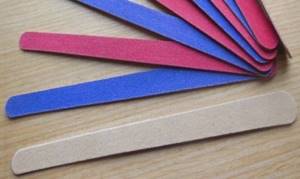
The base of this file is made of cardboard or multi-layer paper and processed in a certain way. On top it is covered with spraying, for which granite, quartz or Teflon chips are used. This file can be used in salons, as a disposable tool, and for personal use - reusable. The impossibility of reusable use of this file in salons is due to the fact that it cannot be disinfected.
Plastic file
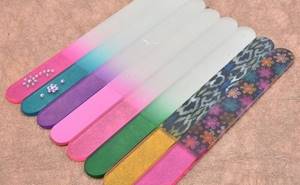
Often, accessories for manicure are quite expensive. A plastic polishing file is an exception in this case. This inexpensive but easy-to-use file is made from foam or regular plastic. This manicure tool can be used to correct thin, fragile nails. It has the characteristics of gentle and non-harsh processing. Plastic files are simply washed and treated with special disinfectants. The variety of assortment and budget price of such a file allows you to choose it for every taste.
Glass file
The glass nail file is loved by many representatives of the fair sex. Its gentle material helps to gently treat and polish your nails. Another advantage of this manicure file is the possibility of long-term use. The only thing is that it is quite fragile and can easily break, therefore, it must be handled with care and preferably stored in a case or case.
Ceramic file
The abrasiveness of its base will facilitate soft, gentle polishing, which will remove all the scales. The ceramic file is also fragile and is usually sold in a special case. If handled with care, it can be used for a very long time.
Laser file
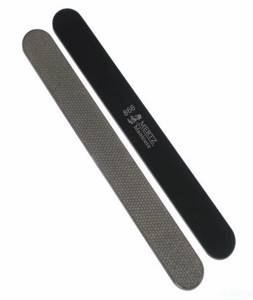
Relatively recently, a tool for treating nails has appeared in stores, with which you can not only polish and shape nails, but also get rid of cuticles. This tool is a laser file. Its base is coated with diamond, but its main distinguishing feature is the presence of small grooves. The small holes look like honeycombs and, unless you look closely, are not particularly visible. Treatment with this nail file will be soft and gentle. It is used for polishing, getting rid of cuticles and removing the rough layer of skin on the sides.
Buffs
Files are in the form of a bar, having two or four working edges, varying in degree of abrasiveness. Often the edges come in different shades and are numbered. Buffs are made from various materials: fabric, suede, polyethylene foam. The disadvantage of buffs is the impossibility of disinfection due to the properties of the material; therefore, they are used at home.
Electric files
In addition to regular polishing files, there are also electric ones. The most popular of them are Scholl, Kemei, Gezatone. They operate on batteries and have several speed modes. The set usually includes several attachments for various purposes. This is a coarser nozzle for forming a plate, a medium coarse one for sanding nails, and the softest for polishing. Electronic files make nail treatment easier and help you achieve the same results as in salons.
In addition to polishing the nail surface, it is convenient to polish the cuticle with similar electric clippers. You just need to be careful not to damage it.
Wax as a polishing agent
Polishing can also be done using wax, especially for those girls who have naturally weak nail plates that are prone to peeling. It helps saturate them with essential vitamins, making them strong and healthy. In order to polish the stratum corneum of the finger with wax, you should prepare a polishing file that has a rubber surface and wax. Next, follow these steps:
- Apply wax and rub it into the horny plate and the skin adjacent to it.
- Using a buff, treat your fingers until they begin to slip.
- Moisten the treated fingers with cream or oil.
Abrasiveness
Manicure files have another distinctive characteristic - abrasiveness. This is the rigidity of their working basis, which is measured in special units - grits. They show the number of abrasive particles on a specific surface area of the tool. Based on this indicator, files are divided into softer, more gentle and rougher. Let's look at the main categories of polishing files based on this characteristic:
- From 250 to 400 grit. This indicator characterizes the soft surface of the base. Used for polishing.
- From 400 to 850 grit. Very soft. Used for more gentle polishing.
- From 850 to 1200 grit. The softest. Buffs usually have this abrasiveness. Used for polishing and giving a glossy shine to the plate.
In the cabin
Nail polishing in the salon is done in several ways: with buffs - special rectangular pads, double-sided pads that have different degrees of hardness, files, oils and balms, creams, scrubs, powders, pastes. All cosmetics must be based on medicinal herbs, oils and algae.
For example, the content of essential oils of eucalyptus and citrus fruits is antiseptic; extracts of tea tree, chili pepper, ginger, and camphor oil can be used as active components in scrubs and balms.
Now there are gel-based creams, the use of which replaces the polishing of natural and artificial nails. This cream dries under an ultraviolet lamp, the time spent under it is only 1 minute. The effect is a smooth and healthy nail surface, which is protected from external negative influences and yellowing.
The cost of such a procedure is within reasonable limits, and the time required is from 20 minutes to 1 hour.
The nail polishing process is greatly speeded up by nail polishing machines. They have several attachments, discs of various shapes and degrees of hardness. In such devices there are different degrees and directions of rotation. Modern nail salons use just such machines, which significantly saves both your time and your manicurist.
Let's look at the main characteristics of buffs
What materials can buffs be made from?
The base is usually made of plastic, wood, silk and other fabrics.
Working surfaces can be:
- polyethylene foam (plastic) - popular, cheap, durable. They can be sterilized;
- silicone can also be washed and disinfected, durable, inexpensive;
- The suede buff may have handles, the quality is average, it is impossible to disinfect;
- a fabric buff is of good quality, suitable for natural nails, elastic, but the cost is higher, especially for a silk-coated buff, and cannot be sterilized.
Nail polisher
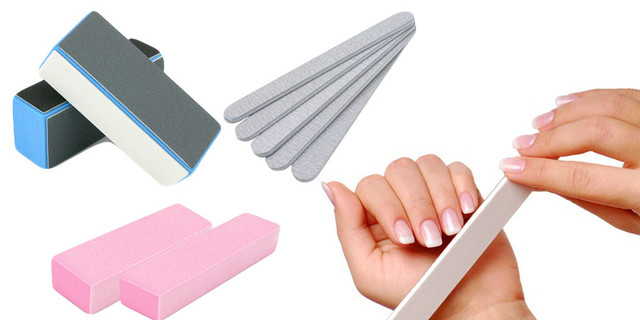
To create a beautiful manicure, many women use a special polisher. There are several types of such tools:
- Sanding buff. It consists of 3-4 surfaces, each of which has a different degree of roughness.
- Disc for hardware manicure. Disks made in the form of a small circle, on the surface of which there is sand intended for polishing the place where the nail begins.
- Set 3 in 1. It consists of a special buffer, sandpaper surface and the polisher itself.
Why use a polisher
The polisher has a big advantage. Only thanks to him can you put the nail plate in order, namely:
- Remove jagged edges and make them smoother.
- Smooth out any uneven surfaces and ensure easy application of the varnish.
- Remove various stains.
- Make your nails more shiny, beautiful and attractive.
- Improves blood circulation, thereby stimulating the growth of nail plates.
As a rule, after the polishing procedure has been carried out, the nails acquire a mirror shine that is simply impossible not to pay attention to. But when carrying out this procedure, you should observe moderation, otherwise it can make your nails thin and brittle. Polishing is an important process in nail care, and only with its help will they become not only beautiful but also healthy.
Tool selection
Experienced craftsmen prefer a mechanical polisher. After using it, the nails become shiny, smooth, and do not get damaged.
Advantages of a mechanical polisher:
- makes the edges smooth;
- removes stains;
- the plate becomes shiny;
- improves blood circulation.
Buffs and sponges are also not inferior to manicure devices, but require more effort to add shine. Files often injure the skin and cuticle, making the plate thin and soft.
Required Polishing Products
The products are intended to nourish and level the plate, enhance shine and beauty, and facilitate the application of varnish.
Required tools:
- polish, cream;
- wax;
- oil.
Care products are essential for thin and brittle nails. They saturate with nutrients and make nails stronger.
Wax
Cosmetic wax contains paraffin, oils, white clay and eleutherococcus extract. The combination of components nourishes the nail, fills cracks and irregularities.
Benefits of wax:

- hypoallergenic;
- easy to apply;
- economical;
- natural composition.
The wax is applied to the finger and rubbed in with a buff, making light polishing movements. It is not recommended to use nail files.
Oil
Essential oils and manicure products strengthen nails and give them a healthy shine. You can purchase a ready-made product or make the product yourself.
What oils are used:
- almond;
- jojoba;
- lemon;
- ylang-ylang.
The oil is applied to a buff or suede sponge and each nail is polished until shiny. The procedure is done once a week.
Nail polish and cream
The cream is intended to improve polishing with a buffer or nail file. The polish is applied after processing the cuticle. The auxiliary fills cracks and irregularities and enhances shine. Economical to use.
Features and Specifications
“Med-heart” offers nail polishing machines of various price categories. Depending on the area of application, the following devices are distinguished:
- Professional. Developed on the basis of industrial technologies for long-term continuous operation in cosmetology rooms, beauty salons, etc. They are distinguished by a high rotation speed (up to 35,000 rpm) with the mandatory presence of a system of smooth or step speed control. Equipped with a quick-release element for changing attachments and performing various polishing operations, removing build-ups, correcting the shape of plates, etc.
- Homemade. They can operate from the mains or built-in power supply. As a rule, they are supplied from the factory with a set of the most popular attachments. Designed for one-time operations when performing a manicure or pedicure on your own. The most powerful devices in this category provide rotation speeds of up to 12,000 rpm.
The main feature of modern nail polishing devices is the ability to quickly change attachments and incredible ease of operation. In addition, additional attachments can be purchased individually or as a set to perform various operations.
To achieve the required shine of the plate, polishing must be carried out in several stages with changing nozzles. First of all, the treatment is carried out with a coarse abrasive with a gradual change towards a finer one. To perform a similar operation at home, you can use a regular diamond file, which allows you to remove large irregularities and various growths. Finally, special felt polishers are used to make the surface perfectly smooth, followed by varnishing. At the same time, regardless of the type of device used, the procedure takes quite a bit of time, and the result exceeds all expectations, even when using a household manicure machine.
Precautionary measures
When rubbing the nail plates yourself at home, you should familiarize yourself with all the available contraindications. First of all, this applies to girls who by nature have a thin exfoliating stratum corneum. Of course, this does not mean that they should completely forget about nail care and abandon such a necessary procedure as polishing. No. Just before you start polishing, you should carefully examine your nails and bring them to the desired state, or, more simply put, take a course of radiation. And you shouldn’t be afraid of this either. Currently, the buyer has a variety of special nail care products to choose from that do an excellent job of their purpose. It’s even better to use such products together with special vitamin complexes that will not only help heal your nails but will also keep them beautiful and healthy.
We recommend visiting our Manicurist Forum , where you can ask questions or chat about interesting topics!
Advantages of a unique nail file
The secret of the buff is that it is usually a block, each edge of which performs a specific task, and this depends on the different abrasiveness of the edges.
What is each edge needed for?
- the first side is a regular file to create the desired shape of nails, they can be shortened and trimmed;
- the second side is used to remove irregularities on the plate - burrs, roughness;
- a third party sands and removes minor imperfections;
- the fourth side polishes the plates, giving them a natural shine.
Polishing sequence
- First, you need to remove the nail polish. It is better to use removers without acetone.
- Then, before the polishing procedure, you can make a nail bath with sea salt. It will help soften the cuticle and nails and saturate them with useful minerals.
- After 15 minutes, the hands are removed from the bath and thoroughly dried with a towel.
- Then the selected nourishing oil is applied to the surface of the nail. They are rubbed with massage movements into the nail plate and surrounding skin.
- Next comes the first stage of polishing with a file of greater abrasiveness.
- After this, the abrasiveness of the file is reduced until the surface of the nail becomes smooth and shiny.
- The final stage of polishing will be the application of nourishing oil to the nail and cuticle area.
It is better to entrust polishing of natural nails to a specialist in a salon. You can order this procedure from us. To do this, you need to contact us at the phone number indicated on the website.
Preparing nails for polishing
For the most part, polishing should be done along with the manicure procedure. However, self-grinding is also allowed if you have the appropriate training.
- Remove the varnish coating from the surface of the plate using a liquid that does not contain acetone.
- Take a glass file of medium abrasiveness and give your nails the desired shape. If you prefer a square, then make the corners smooth so as not to provoke delamination.
- Next, you need to steam the skin to evenly remove the cuticle. To do this, make a bath: brew 50-60 g. geranium or rosemary in 1.5 liters of boiling water, leave the broth until it cools partially and dip your fingers in it for a quarter of an hour. When the time is up, dry your hands and move the cuticle to the base of the plate.
- With your free hand, pull back the sides of the finger, remove the keratinized layers of skin with tweezers, try not to touch the healthy epidermis to avoid infection. Move from both sides to the middle of the cuticle (base of the nail). At the end of the manipulations, soak a cotton swab in hydrogen peroxide and wipe your nails and the skin around them.
how to strengthen weak nails at home



